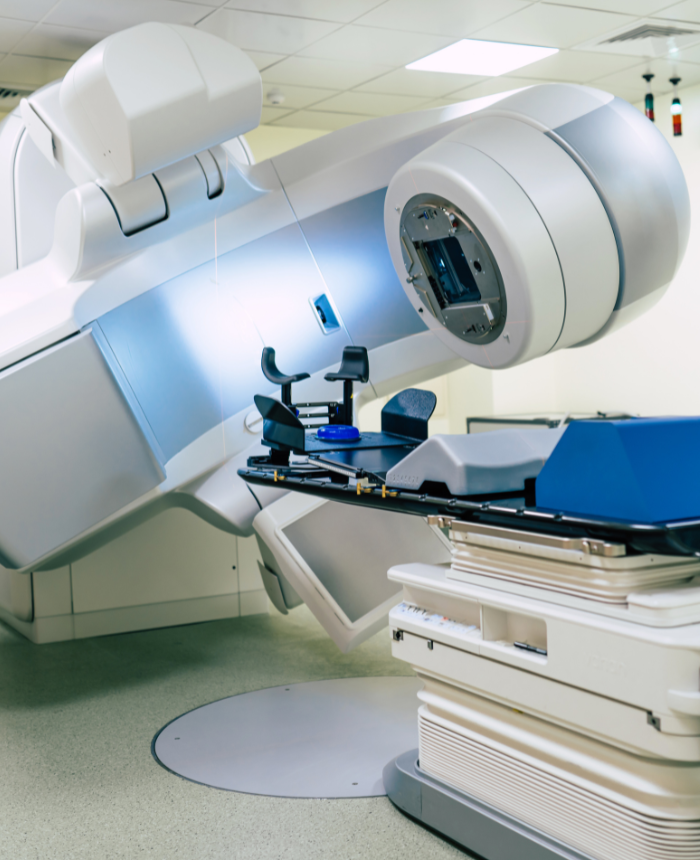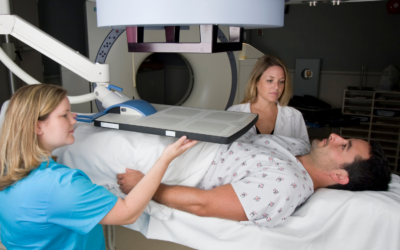
Treatment Technology
IMRT
Intensity Modulated Radiation Therapy
Radiation therapy is used to damage the DNA of cancer cells, stop them from growing and spreading and, in many cases, shrink or eliminate tumors completely. External beam radiation therapy (EBRT) is one type of radiation therapy in which tightly targeted radiation beams are delivered to cancer cells from a source outside the body – usually a linear accelerator – in an experience many patients describe as similar to having an x-ray or CT scan.
One of the most common types of radiation therapy for prostate cancer is IMRT, or Intensity Modulated Radiation Therapy. It is an advanced form of external radiation treatment in which the size and intensity of the radiation beams can be adjusted to specifically target prostate cancer cells while avoiding the healthy surrounding cells. The IMRT radiation beams can be customized to the exact shape of the cancer cells they are targeting, allowing them to be used on cancers and tumors anywhere in the body.
Not only does this protect healthy cells, but the targeted nature of this computer-driven radiation therapy lets doctors deliver as high a dose of radiation to the cancer cells as is necessary for treatment.
Integrated Cancer Care is proud to offer treatments using Halcyon™ Radiotherapy System, which is the most advanced system available for radiation therapy treatment.
Halcyon delivers treatment faster, delivering radiation beams in about half the time as conventional radiation therapy treatments—or in as little as 17 seconds. This shorter treatment time helps improve the accuracy of treatments; with less time on the table, the potential for movement during treatment is greatly reduced.
In addition, Halcyon shapes its radiation beams to conform to the treatment area. This is especially effective when treating prostate cancer and improves our ability to avoid healthy tissue. By avoiding healthy tissue, side effects are reduced and recovery is faster.
And Halcyon does all this with patient comfort in mind. Its operations are smoother and quieter than other linear accelerators, the treatment couch is placed lower for easier access, ambient lighting and optional music can aid in relaxation, and more.
IMRT Patient Resources
Here are some resources to help you better understand your treatment; how to prepare for treatment; and what to expect before, during, and after treatment occurs.
How Long Does a Radiation Treatment Take?
How long does a single radiation treatment will take? It depends. Here, we’ll provide some answers that we hope will help prepare you for your radiation therapy journey.
How Radiation Oncology Centers Treat Prostate Cancer
Prostate cancer can be treated by radiation oncology centers using external beam radiation therapy (EBRT) or internal radiation (brachytherapy). Learn more here.
How IMRT for Prostate Cancer Helps Prevent Cancer Spread
Using IMRT for prostate cancer treatment kills cancer cells and helps stop the spread of cancer—improving a patient’s overall prognosis.
FAQs
How does IMRT work?
With IMRT, the radiation oncologist matches both the dose and the targeting to match your unique tumor. This is done through the use of many small sub-beams of radiation, rather than through one large beam. Each sub-beam can be positioned individually, allowing us to deliver a higher dose of radiation to the tumor while at the same time minimizing any damage to healthy tissue. The sub-beams also have varying intensities of radiation based on their positioning—thus, the process is called intensity-modulated radiation therapy (IMRT).
What is IMRT used for?
In addition to using IMRT for prostate cancer, this radiation therapy is also used to treat cancers where the tumor either surrounds or is very close to a healthy part of the body – especially near sensitive organs. It is often used for head and neck cancers, brain tumors, gastrointestinal cancers, lung cancers, and gynecologic cancers, among many more.
What does IMRT look like?
After your initial planning sessions and simulation, your treatments will mostly consist of short weekday sessions approximately 10-15 minutes in length. With IMRT, small doses of radiation are given on a daily basis in order to help reduce damage to the healthy tissues around the tumor. Weekend rest breaks help facilitate this, giving your normal cells a chance to heal and recover.
At the beginning of each appointment, your radiation therapist will position you on the treatment table. Sometimes, foam blocks or other devices are used to ensure positioning and, because IMRT treatments are very precise, your therapist may mark your body with dots of ink to better position you accurately.
After positioning you, your radiation therapist will leave to activate the machine from a nearby area, allowing your radiation treatment to begin. Your radiation therapist will observe your treatment, can communicate with you via a two-way intercom, and can stop the machine at any time.
During the treatment, the machine will shift position around you as it delivers the treatment to your body. Patients do not feel the radiation during treatment. IMRT is generally quick and painless, with patients remaining aware throughout the process. After your treatment session is over, you’ll be able to leave and continue your normal day-to-day activities.
The radiation oncologist will see you once a week to discuss how you are feeling and address any concerns.
What is the difference between IGRT vs IMRT?
Image Guided Radiation Therapy, or IGRT, is used in conjunction with IMRT radiation treatment to add greater precision and localize radiation treatment. Not all patients require IGRT, but it is often used in cancers that occur very close to sensitive organs or which are prone to movement between or during treatments. It is often used alongside IMRT for prostate cancer to reduce radiation exposure to healthy tissues in the bladder, rectum, or penile bulb.
Your Radiation Therapy Journey
Our team offers several radiation treatments for prostate cancer at both of our cancer centers. Click below to learn more about our cancer care technologies, see frequently asked questions about prostate cancer, discover resources and information to support you on your cancer journey, and find out what you can expect from treatment.
Technologies
Learn More about our cancer care technologies
We offer 3D-CRT, CT Scanning & Simulation, IGRT, IMRT, and Cone Beam CT.
Resources
Frequently Asked Questions
Have a question about prostate cancer? We've got answers.
Prostate Cancer Scans
At Integrated Cancer Care, we are committed to delivering the highest quality patient care to our prostate cancer patients.
At Integrated Cancer Care, we offer the highest quality radiation therapy for prostate cancer through a comprehensive and multi-disciplinary approach designed to enhance clinical outcomes where possible. Integrated Cancer Care’s board-certified radiation oncologist, Dr. Tracy R. Price, provides on-site radiation oncology services for prostate cancer patients using proven technologies.
Schedule Your Appointment Today
If you are referred to radiation therapy during your cancer care, you get to choose where to receive treatment. We are here to support and encourage you—call us today to schedule your first appointment at our radiation oncology center nearest you.







